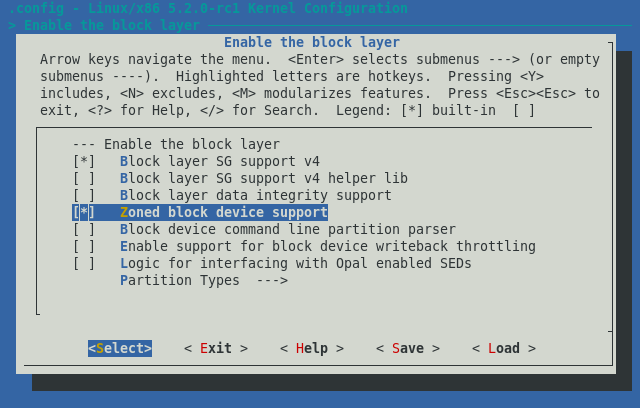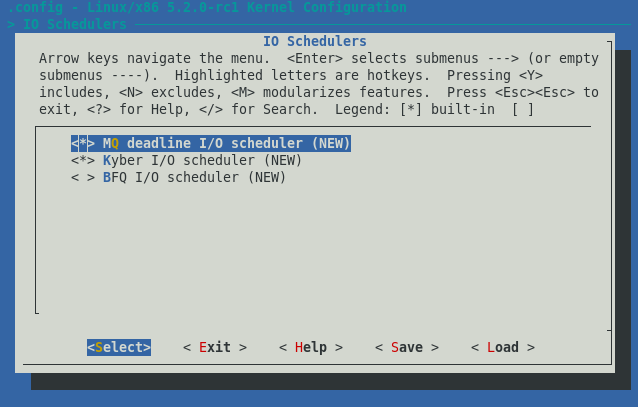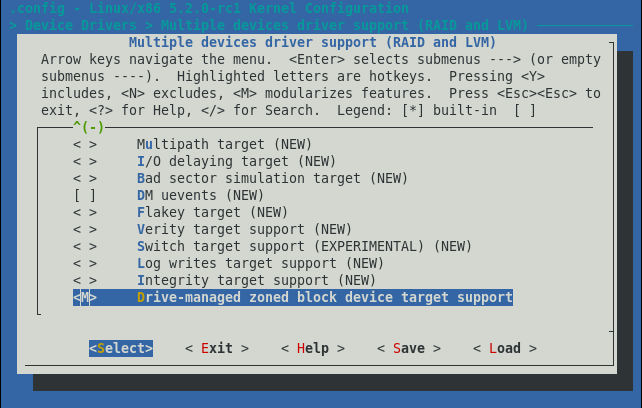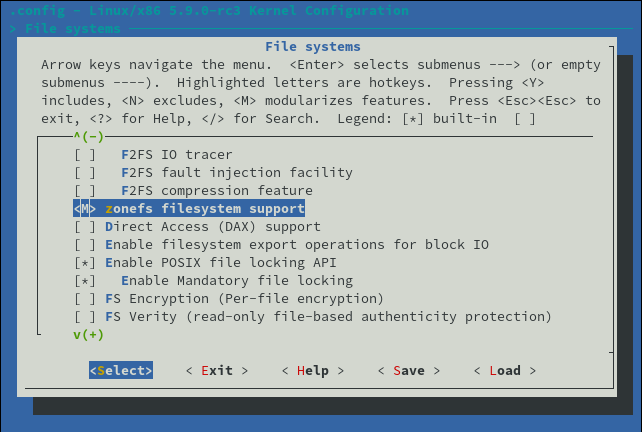Kernel Configuration
Several kernel compilation configuration options control zoned block device support features.
Block Layer
Zoned Block Devices Core Support
To allow supported zoned block devices to be exposed as block device files,
enable the block-layer configuration option CONFIG_BLK_DEV_ZONED. This option
is part of the Enable the block layer top menu of make menuconfig.

Setting this configuration option gives users access to the ZBD interface. If this configuration option is not set, users do not have access to the ZBD interface and support for zoned block devices is disabled in all kernel subsystems that include support for these devices (this includes I/O schedulers, device mappers, and file systems).
Write Ordering Control
For kernels starting with versions 4.16 and up to version 6.9, write operation
ordering control is achieved using the deadline (legacy single queue
block I/O path) and mq-deadline (multi-queue block I/O path) block I/O
schedulers (see Write Ordering Control). deadline and
mq-deadline zoned block device support is automatically enabled if the
CONFIG_BLK_DEV_ZONED configuration option is set.
It is mandatory to enable this scheduler for zoned block devices for kernel
versions 4.16 to 6.9. The configuration option CONFIG_MQ_IOSCHED_DEADLINE
enables the mq-deadline scheduler. The configuration option
CONFIG_IOSCHED_DEADLINE enables the deadline scheduler. Both options can be
selected from the IO Schedulers top menu.

As of kernel version 5.0, support for the legacy block-layer single-queue I/O
path has been removed. Only the mq-deadline scheduler remains. As of kernel
version 5.2, CONFIG_MQ_IOSCHED_DEADLINE is automatically selected when the
CONFIG_BLK_DEV_ZONED configuration option is set.
Strating with kernel 6.10, write ordering control is implemented by the block I/O layer, outside of the block I/O scheduler, using zone write plugging. This new implementation still allows using the mq-deadline block I/O scheduler but does not mandate its use with a zoned block device. That is, the none scheduler can be used with fast NVMe SSDs supporting the zoned namespace feature.
Device Drivers Configuration
null_blk Logical Device
The CONFIG_BLK_DEV_ZONED configuration option automatically enables support
for zoned block device emulation that uses the null_blk device driver.
ZBC and ZAC Hard-Disks Support
SCSI subsystem support for ZBC and ZAC SMR disks is automatically enabled with
the CONFIG_BLK_DEV_ZONED configuration option.
NVMe Zoned Namespace Solid State Disks Support
The NVM Express Zoned Namespace Command Set depends on CONFIG_BLK_DEV_ZONED
and CONFIG_NVME_CORE. It is automatically built if both of these configuration
options are enabled.
This driver requires the device to support the Zone Append command to successfully bind to a zoned namespace. It does not support Zone Excursions. See Zoned Namespace (ZNS) SSDs for more details about these features.
Device Mapper
Zoned block device support for the device mapper subsystem is automatically
enabled when the CONFIG_BLK_DEV_ZONED option is set. This enables support for
dm-linear and dm-flakey targets. Note that the dm-zoned device mapper
target must be enabled to be usable.
Enable the dm-zoned target by selecting the CONFIG_DM_ZONED option from the
menu Device Drivers --> Multiple devices driver support (RAID and LVM) -->
Device mapper support --> Drive-managed zoned block device target support.

File Systems
f2fs
Support for zoned block devices in the f2fs file system
is automatically enabled with the CONFIG_BLK_DEV_ZONED configuration option.
zonefs
Enable compilation of the zonefs file system by selecting the
CONFIG_ZONEFS_FS option from the menu File systems -> zonefs filesystem
support. This option is available only if the CONFIG_BLK_DEV_ZONED option is
set to enable zoned block device support.

Kernel Compilation
The kernel compilation process is the same regardless of whether the kernel has been configured to enable zoned block device support. When the kernel has been configured to enable zoned block device support, the following commands will build the kernel.
$ make all
The kernel build infrastructure also allows you to build .rpm or i.deb packages. To build RPM packages, use the following command.
$ make rpm-pkg
Kernel Installation
The procedure for installing a zoned-block-device-enabled kernel is the same as the procedure for installing a regular kernel. Use the following command to install the kernel locally.
$ sudo make modules_install install
Follow this command by configuring the system bootloader (if your distribution requires it). Some distributions might not require you to configure the system bootloader.
Then restart the host system to execute the newly-compiled and newly-installed kernel, on which you have enabled support for zoned block devices.
At this point in the installation process, we highly recommend reinstalling the kernel headers. By reinstalling the kernel headers, the file /usr/include/linux/blkzoned.h will be installed, which will allow applications to be compiled against the zoned block device API supported by the kernel.
Run the following command to install the kernel user header files.
$ sudo make headers_install
See the kernel's make help output for more information on this directive.
After the the kernel user header files have been installed, we recommend that you recompile from source any package that will be used to manage and access zoned block devices. In particular, recompiling and re-installing Linux system utilities is highly recommended because many packages rely on util-linux zoned block device features (e.g. file systems that use libblkid).
The installation of the kernel and the installation of the user header files can
be simplified by using the RPM packages that are generated with the make rpm-pkg command. If you install all of the packages generated by that command,
you will install the kernel core itself, the associated driver modules, and the
user API herder files. The RPM package kernel-headers-<version>.<arch>.rpm
must be installed in order for the kernel user API header files to be updated.